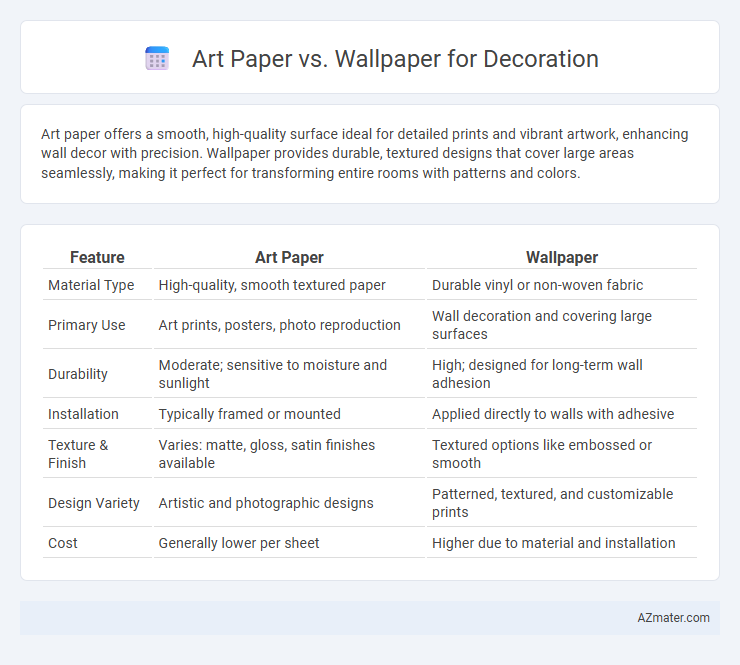Art paper offers a smooth, high-quality surface ideal for detailed prints and vibrant artwork, enhancing wall decor with precision. Wallpaper provides durable, textured designs that cover large areas seamlessly, making it perfect for transforming entire rooms with patterns and colors.
Table of Comparison
| Feature | Art Paper | Wallpaper |
|---|---|---|
| Material Type | High-quality, smooth textured paper | Durable vinyl or non-woven fabric |
| Primary Use | Art prints, posters, photo reproduction | Wall decoration and covering large surfaces |
| Durability | Moderate; sensitive to moisture and sunlight | High; designed for long-term wall adhesion |
| Installation | Typically framed or mounted | Applied directly to walls with adhesive |
| Texture & Finish | Varies: matte, gloss, satin finishes available | Textured options like embossed or smooth |
| Design Variety | Artistic and photographic designs | Patterned, textured, and customizable prints |
| Cost | Generally lower per sheet | Higher due to material and installation |
Introduction to Art Paper and Wallpaper for Decoration
Art paper and wallpaper serve distinct roles in interior decoration, with art paper primarily used for creating artistic prints, drawings, and high-quality visual displays, emphasizing texture and color precision. Wallpaper is designed for broader wall coverage, featuring repetitive patterns or designs that enhance the aesthetic appeal of spaces while providing durability and ease of maintenance. Both materials contribute unique decorative elements, with art paper suitable for framed artwork and wallpaper ideal for large-scale wall transformations.
Key Differences Between Art Paper and Wallpaper
Art paper features a smooth, high-quality surface ideal for detailed prints and fine art reproductions, whereas wallpaper is designed with durability and ease of installation for wall coverage in various textures and patterns. Art paper typically uses archival-grade materials to preserve artwork, while wallpaper focuses on resistance to moisture and wear for long-term wall application. The primary difference lies in their intended use: art paper enhances visual art presentations, while wallpaper transforms interior spaces with decorative and functional wall coverings.
Material Composition: Art Paper vs Wallpaper
Art paper is typically made from high-quality cellulose fibers, offering a smooth, matte surface ideal for archival-quality prints and detailed artwork reproduction. Wallpaper is composed of multiple layers, often including a backing material such as vinyl or fabric, which provides durability and resistance to moisture, making it suitable for long-term wall decoration. The material composition of art paper focuses on print fidelity and texture, while wallpaper emphasizes strength, washability, and ease of installation.
Design Variety and Customization Options
Art paper offers a wide range of intricate designs, textures, and finishes, allowing for detailed customization to suit specific artistic styles and room themes. Wallpaper provides extensive design variety as well, including patterns, colors, and large-scale prints, with options for customization such as removable or textured surfaces. Both materials cater to diverse aesthetic preferences, but art paper excels in fine art reproduction and bespoke creative projects, while wallpaper is ideal for expansive, cohesive decorative coverage.
Installation Process and Ease of Application
Art paper offers straightforward installation with common adhesives and can be trimmed easily for precise application, making it ideal for DIY projects. Wallpaper often requires specialized paste and tools for pattern alignment and seamless coverage, which might demand professional installation. Both materials vary in preparation and application time, but art paper generally provides a quicker, less complex decorating solution.
Durability and Maintenance Comparison
Art paper offers superior durability due to its thicker, high-quality fibers, making it resistant to tearing and fading over time, ideal for long-lasting decorative projects. Wallpaper, while available in various materials like vinyl or non-woven, generally requires more maintenance as it is prone to peeling, staining, and damage from moisture if not properly sealed. Maintenance for art paper involves minimal cleaning with gentle dusting, whereas wallpaper often demands careful handling and occasional repairs to maintain its appearance.
Cost Analysis: Art Paper vs Wallpaper
Art paper typically costs more than wallpaper due to its premium quality, texture, and specialized printing techniques, often ranging from $30 to $100 per roll. Wallpaper offers a more budget-friendly option with prices generally between $15 and $50 per roll, ideal for covering large surfaces cost-effectively. When considering long-term investment, art paper's durability and aesthetic appeal may justify higher upfront costs compared to wallpaper's affordability and ease of installation.
Best Use Cases for Art Paper in Interior Design
Art paper excels in interior design when showcasing fine artwork, prints, or photography, offering a smooth, high-quality surface that enhances color accuracy and detail. It is ideal for framing and creating focal points in living rooms, galleries, or offices where visual impact is essential. Compared to wallpaper, art paper provides versatility for personalized decor, allowing designers to experiment with texture, finishes, and custom prints to elevate aesthetic appeal.
Ideal Scenarios for Choosing Wallpaper
Wallpaper is ideal for creating dramatic accent walls or adding intricate patterns and textures that paint alone cannot achieve, making it perfect for living rooms and feature walls. It offers durability and easy maintenance in high-traffic areas like hallways and kitchens, where frequent cleaning is necessary. Wallpaper is also excellent for covering imperfections on walls, providing a smooth, flawless surface that enhances sophistication in both modern and traditional interior designs.
Eco-Friendliness and Sustainability Considerations
Art paper, often made from recycled fibers and sustainable materials, offers a biodegradable and low-impact option for eco-conscious home decoration. Wallpaper, while durable and visually versatile, may contain PVC or non-biodegradable coatings that challenge sustainability efforts. Choosing art paper printed with soy-based or water-based inks reduces environmental harm, enhancing green interior design practices.

Infographic: Art paper vs Wallpaper for Decoration
 azmater.com
azmater.com